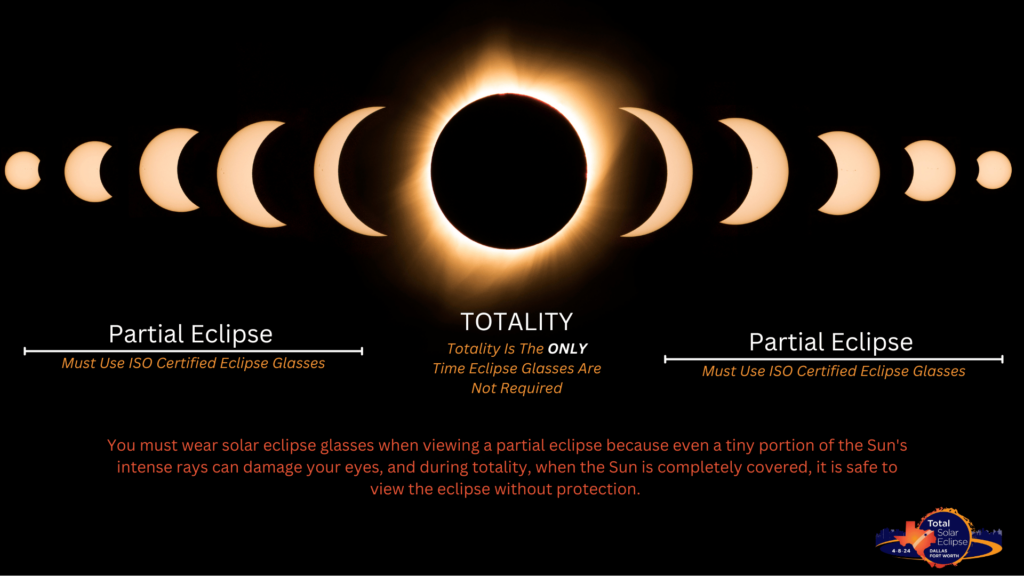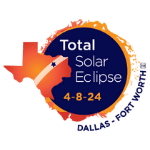Eclipse FAQ: Total Eclipse DFW – April 8, 2024

Welcome to the Total Eclipse DFW website’s Eclipse FAQ page, your resource for the information you need about the upcoming Total Solar Eclipse in 2024 passing right through DFW. We understand that this once-in-a-lifetime celestial event is generating immense interest and curiosity, and our goal is to provide you with answers to the most common questions that Eclipse enthusiasts like you may have. Whether you’re wondering about the best viewing locations in the Dallas-Fort Worth area, the timing of the Eclipse or how to safely witness this extraordinary phenomenon, you’ll find it all right here. If we don’t have the answer right now, send us an email and we will ask our experts and get it posted ASAP.
What are the five phases of a Total Solar Eclipse?
A total solar eclipse is composed of five distinct phases. These stages are as follows:
- Partial eclipse begins- First Contact: The Moon starts to move in front of the Sun, creating the impression that a portion of the Sun has been bitten off by the Moon.
- Total eclipse begins- 2nd Contact: The Moon continues its path, completely concealing the Sun’s disk. Observers are now within the Moon’s umbra, the darkest part of its shadow. Just before Totality, the diamond ring effect and Baily’s beads can be seen.
- Totality and maximum eclipse: The Moon entirely covers the Sun’s disk, revealing only the Sun’s corona. This phase is the most striking moment of a Total Solar Eclipse. During this time, the sky goes dark, temperatures may drop, and birds and animals may become silent. The midpoint of Totality is referred to as the maximum point of the Eclipse.
- Total eclipse ends – 3rd Contact: The Moon starts to move away from the Sun, and the Sun begins to reappear. After totality, those fortunate enough to be within the Moon’s umbral can observe the diamond ring effect and Baily’s beads.
- Partial eclipse ends – 4th Contact: The Eclipse concludes as the Moon exits the Sun’s disk.
What does totality mean when talking about the solar eclipse?
During the phase of a total solar eclipse known as totality, the moon completely covers the sun. Just prior to this phase, as the amount of sunlight decreases and the sky begins to darken, it may be possible to observe several stars and planets in the sky.
Why is the Path of Totality so narrow?
The Path of Totality during a solar Eclipse is relatively narrow because it is determined by the shadow cast by the Moon as it passes in front of the Sun which depends on the closeness of the Moon to the Earth. For this Eclipse, the Moon’s shadow is roughly 120 miles wide as it crosses DFW. The shadow is wider than the Total Solar Eclipse of August 21, 2017, hence the longer Eclipse time along the path.
Why are Total Solar Eclipses rare?
Total Solar Eclipses are rare at any one point on Earth because the alignment of the Sun, Moon and Earth must be nearly perfect for the Moon to cover the Sun completely and it only happens along the path. The Path of Totality is also relatively narrow, so only a small area of the Earth’s surface can experience a total Eclipse.
However, for those with the desire and means, Total Solar Eclipses occur on average every eleven to eighteen months somewhere on the planet.
What are some tips for observing a Total Solar Eclipse?
- Location. Make sure the location you pick is within the Path of Totality. The closer to the centerline, the longer of Totality. Fort Worth will be at 2 minutes and 21 seconds of Totality, Dallas at 3 minutes and 53 seconds, Mesquite at 4 minutes and 4 seconds and Rockwall at 4 minutes and 6 seconds. Check out your city here.
- Eye Safety – during a partial or ring (annular) Eclipse, obtain and use proper eye protection when looking at the Sun. View it only through special-purpose ISO 12312-2 Compliant filters or use projection methods available at https://Eclipse.aas.org/eye-safety.
- Weather – this is Texas. The great thing is that we have great interstates and backroads in Texas. DFW is one of the better weather locations along the path of the Eclipse
- Filters for binoculars and cameras, during partial phases of the Eclipse, you’ll need special filters that go in front of the binoculars and camera lenses to protect your eyes.
- From First Contact to Last Contact is almost three hours, bring water, a chair, a blanket and snacks. Arrive early to get a good spot if you join a group event.
- Accessibility be aware of your party’s physical abilities and needs when choosing a location.
To observe a Total Solar Eclipse safely, always use proper eye protection and never look directly at the Sun. You should also check the weather forecast and plan to be in a location with clear skies. Also, it’s a good idea to bring a chair or blanket to sit on and arrive early to secure a good viewing spot.
What is the difference between a Total and Partial Solar Eclipse?
A Total Solar Eclipse occurs when the Moon completely covers the Sun. In contrast, a partial solar Eclipse occurs when the Moon only partially covers the Sun. During a partial Eclipse, the Sun appears crescent rather than completely covered by the Moon. All of Texas will see a partial Eclipse on April 8, 2024 (weather permitting). Only those in the Path of Totality will see a Total Eclipse. Warning – 99% is NOT good enough. You will miss Totality.
Why is it important to use proper eye protection during a Solar Eclipse?
During a Partial or Total Solar Eclipse, such as the one on April 8, 2024, looking directly at the Sun is unsafe except during the brief total phase (“Totality”), when the Moon entirely blocks the Sun’s bright face, which happens only within the narrow Path of Totality. Looking directly at the Sun, even during a partial Eclipse, can cause permanent eye damage or blindness. Therefore, proper eye protection, such as special Solar Eclipse glasses or a solar filter on a telescope, is necessary to observe the Eclipse safely.
Can animals be affected by a Total Solar Eclipse?
Animals are sensitive to changes in light and during Solar Eclipses, you’ll see them exhibit behaviors associated with sunset. Birds will go to roost, cows head to the barn, crickets start singing and nocturnal animals become active. Your pets may do the same.
Can you take photos or videos of a Total Solar Eclipse?
You can take photos or videos of a Total Solar Eclipse, but you must use proper equipment and techniques to avoid damaging your camera or smartphone. For example, you should use a solar filter on your camera lens, smartphone, or special Eclipse glasses to align your camera with the Sun to capture the Eclipse.
What are some scientific discoveries that have been made during Total Solar Eclipses?
Total Solar Eclipses provide unique opportunities for scientists to study the Sun’s atmosphere, known as the corona. Researchers study the corona in detail during Eclipses and investigate its composition, behavior and learn more about our life-giving start. Several big discoveries have been made during Solar Eclipses.
- The discovery of Helium in 1868.
- The confirmation of Einstein’s theory of general relativity in 1919
- The discovery of Solar Wind in 1952
What is the Path of Totality?
The Path of Totality is the narrow path on the Earth’s surface where a Total Solar Eclipse can be observed in its entirety. The Path of Totality is determined by the relative positions of the Sun, Moon and Earth. It can vary in width from a few kilometers to hundreds of kilometers. Outside of the Path of Totality, only a Partial Solar Eclipse can be observed.
How can I prepare for a Total Solar Eclipse?
To prepare for a Total Solar Eclipse, you should research the timing and location of the Eclipse, check the weather forecast and plan to be in a location with clear skies. You should also obtain proper eye protection, such as special solar Eclipse glasses or a solar filter for a telescope, to safely observe the Eclipse. It is also a good idea to arrive early to secure a good viewing spot and bring a chair or blanket.
Where can I order Solar Eclipse glasses?
Well, you are in luck! Total Eclipse DFW has you covered. Go to https://totaleclipsedfw.com/order-eclipse-glasses/ for more information.
What counties does Total Eclipse DFW cover?
More Total Eclipse DFW Counties
Where can I find the cities in the Path of Totality?

